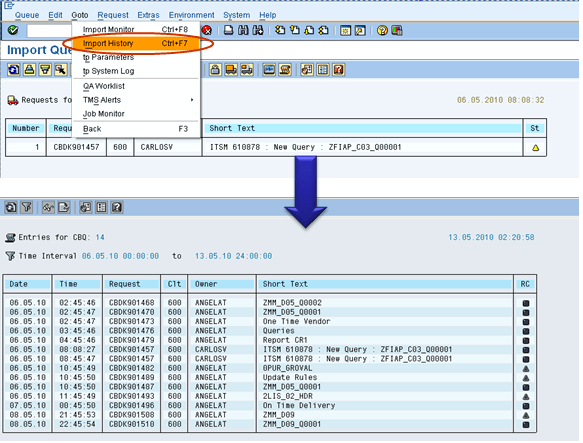How to Request Idp to Re Send Report Again
What is a Transport Request?
- Transport Requests (TRs) – is a kind of 'Container / Collection' of changes that are made in the evolution system. It also records the data regarding the type of change, the purpose of transport, request category and the target system. It is also known as Change Requests.
- Each TR contains one or more alter jobs, also known every bit change Tasks (minimum unit of measurement of transportable modify). Tasks are stored inside a TR, just like multiple files are stored in some binder. TR tin be released but once all the tasks inside a TR are completed, released or deleted.
- Change Task is actually a list of objects that are modified by a particular user. Each task tin can be assigned to (and released by) but one user. Still multiple users tin be assigned to each Transport Asking (as it can contain multiple tasks). Tasks are non transportable by themselves, but just as a part of TR.
Modify requests are named in a standard format every bit: <SID>M<Number> [Non modifiable past system administrators]
- SID – System ID
- K – Is stock-still keyword/alphabet
- Number – can be anything from a range starting with 900001
Instance: DEVK900030
Tasks also employ the same naming convention, with 'numbers' consecutive to the number used in TR containing them.
For Instance, Tasks in the to a higher place mentioned TR Example tin be named equally: DEVK900031, DEVK900032 …

- The project manager or designated atomic number 82 is responsible to create a TR and assign the projection members to the TR by creating chore/s for each project member.
- Hence, she/he is the owner with control of all the changes that are recorded in that TR and therefore, she/he tin can just release that TR.
- However, assigned projection members can release their respective change tasks, once completed.

Workbench Request – contains repository objects and also 'cross-client' customizing objects. These requests are responsible for making changes in the ABAP workbench objects.
Customizing Asking – contains objects that vest to 'customer-specific' customizing. Every bit per client settings, these requests are automatically recorded as per when users perform customizing settings and a target system is automatically assigned as per the transport layer (if defined).
SE01 – Transport Organizer – Extended View

Create a Change Request
- Change Request tin can exist created in two ways:
- Automatic – Whenever creating or modifying an object, or when performing customizing settings, the system itself displays the 'Dialog box' for creating a change asking or mention name of an already created request, if available.
- Manually – Create the change request from the Transport Organizer, and then enter required attributes and insert objects.

- Position the cursor on the TR name or a Task name & choose the Release icon (Truck), a tape of the TR is automatically added to the advisable import queues of the systems defined in the TMS.
- Releasing and importing a request generates export & import logs.

The Import Process
Importing TRs into the target system
- After the request possessor releases the Ship Requests from Source organization, changes should appear in quality and production system; however, this is not an automated process.
- As soon every bit the export process completes (releasing of TRs), relevant files (Cofiles and Data files) are created in the common send directory at Os level and the entry is made in the Import Buffer (OS View) / Import Queue (SAP App. View) of the QAS and PRD.
- Now to perform the import, we need to admission the import queue and for that, we need to execute transaction lawmaking STMS -> Import Button OR select Overview -> Imports
- Information technology will show the list of systems in the current domain, description, and a number of requests available in Import Queue and the status.
Import Queue -> is the list of TRs bachelor in the common directory and are ready to exist imported into the target system, this is the SAP Application View, at the OS level it is as well known as Import Buffer.

The Import Status
Import Queue shows some standard 'status icons' in the terminal cavalcade, here are the icons with their meanings, every bit defined by SAP:

In example, a request is not added automatically in the import queue/buffer, fifty-fifty though the OS level files are present, so we can add such requests by the following method, all the same, we should know the proper name of intended TR:

Import History
Nosotros can as well check the previous imports that happened in the system as follows:

Transport logs and return codes
- Afterwards the send has been performed, the organization administrator must cheque whether it was performed properly or not, for that SAP has provided us with the following type of logs (SE01 -> GOTO -> Send Logs):
- Action Log – which displays actions that have taken place: exports, examination import, import and and then forth.
- Send Logs – which proceed a record of the transport log files.
- One of the important data provided by logs are the return codes:
- 0: The export was successful.
- 4: Warning was issued but all objects were transported successfully.
- 8: A warning was issued and at to the lowest degree one object could not be transported successfully.
- 12 or college: A critical mistake had occurred, generally not caused by the objects in the request.
Source: https://www.guru99.com/what-is-transport-request-how-to-importexport-it-check-logs.html
0 Response to "How to Request Idp to Re Send Report Again"
Enviar um comentário